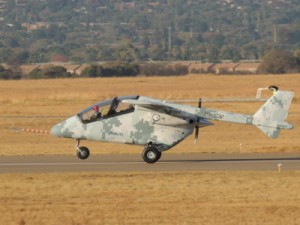2014-08-13 by Guy Martin
The first Paramount Group Advanced High-performance Reconnaissance Light Aircraft (AHRLAC) prototype has performed its maiden flight and has embarked on a rigorous flight testing programme.
The Experimental Demonstrator (XDM) prototype’s first flight to the public took place this morning at Wonderboom airport outside Pretoria, although the aircraft took to the skies for the first time on 26 July.
The aircraft was piloted by test pilot ‘Blokkies’ Joubert on its maiden flight, who flew the aircraft for around 35 minutes. He reached an altitude of 9 000 feet and a speed of around 120 knots as he evaluated the aircraft’s handling abilities. So far, the XDM aircraft has flown seven hours.
Testing has gone well, with no systems failures so far. The first prototype will probably fly 100-200 hours before Paramount and prime contractor Aerosud are satisfied with initial testing. During test flights a Cessna Caravan has been used as a chase plane, but future test flights will use a faster Pilatus PC-12.

Construction of the second prototype (Advanced Demonstrator – ADM) is currently underway, and this will be used to test weapons and sensors, mission equipment and other hardware as the first prototype is being used mainly for handling tests.
The ADM model will be finished around the end of this year and undergo flight testing from the second quarter of next year, according to programme leader Paul Potgieter Junior.
Aircraft could be delivered from the end of next year. Initially production will probably stand at four to eight in the first year then three to five a month after that as production ramps up.
Production will take place at a new dedicated factory. Paramount is in advanced discussions with a number of potential customers and has started marketing the aircraft.
“AHRLAC is a home grown, world class capability that will enable developing countries and advanced nations to strengthen and diversify their security infrastructure. It offers the global industry a new, very cost effective and multi-role solution that will change the way global air forces procure and structure their air fleets. AHRLAC is a solution shaped for today’s modern threats like insurgencies, piracy, poaching and terrorism,” Ichikowitz said.
Paramount said the aircraft can perform tasks previously carried out by four separately configured aircraft, as it integrates designs from attack helicopters, surveillance platforms and reconnaissance aircraft with the ability to carry surveillance, weapons, radar and electronic warfare systems.
AHRLAC has been designed for both civilian and military missions and can be configured for a variety of roles due to its innovative interchangeable mission pod. Roles include patrol and reconnaissance, intelligence gathering, close air support, training, cargo and light attack. “This enables the aircraft for multi-role uses which include disaster management, internal security, border control, maritime patrol and environmental protection,” Paramount said.
Aerosud Managing Director Dr Paul Potgieter said the AHRlAC was designed as a low cost homeland security solution. “To compete with the best in the world we had to apply the very latest technology to find that competitive edge, starting with using the very latest digital design and manufacturing techniques.” Potgieter said he believed the AHRLAC is the most detailed CATIA design ever undertaken in this category, with every part, down to the rivets and screws, being designed digitally. This resulted in the aircraft being built without jigs, saving time and cost.
Potgieter told journalists during a briefing at Wonderboom that four features of the AHRLAC stand out. The pusher propeller configuration allows for an unobstructed forward view, for pilots, sensors and weapons, and also allows for jet-like pilot training, something that has attracted a lot of interest. Other highlights include the interchangeable payload pod, the six hardpoints on the wings and the rugged landing gear that allows for operation on unprepared airstrips.
The AHRLAC is being developed by Paramount with Aerosud as the prime contractor, but the project also involves local and international suppliers. Global suppliers include Pratt & Whitney (PT6 engine), Cobham (antennae/communications) and Zeiss (electro-optical equipment. Local suppliers will include Paramount Advanced Technologies, the Council for Scientific and Industrial Research and Denel (which will supply weapons like the Mokopa missile, amongst other items).
During a post-flight media briefing, Ichikowitz said the AHRLAC reinvented the way aircraft are developed and produced, not just in South Africa but around the world. “This is without doubt a truly historic moment in the South African aerospace and aviation industry. What we have witnessed today has relevance for the whole country and the continent.”
Ichikowitz said that the aerospace and defence industries are often a prime driver of economic growth and the innovation that comes with it and that the South African defence industry has long been an innovator. “This project shows this industry is still alive and well. AHRLAC is exciting but what is going to happen around ARHLAC is very exciting. It marks the rebirth of a dormant industry – that is what is exciting for me…One of the challenges we have on this continent is we still suffer from self-doubt – this project proves we can build things that have been designed in Africa for African conditions.”
“Watch this space,” Ichikowitz told journalists. “This is just the beginning as more can be expected from AHRLAC, Paramount and South Africa.”
Republished with the permission of our partner defenceWeb:

